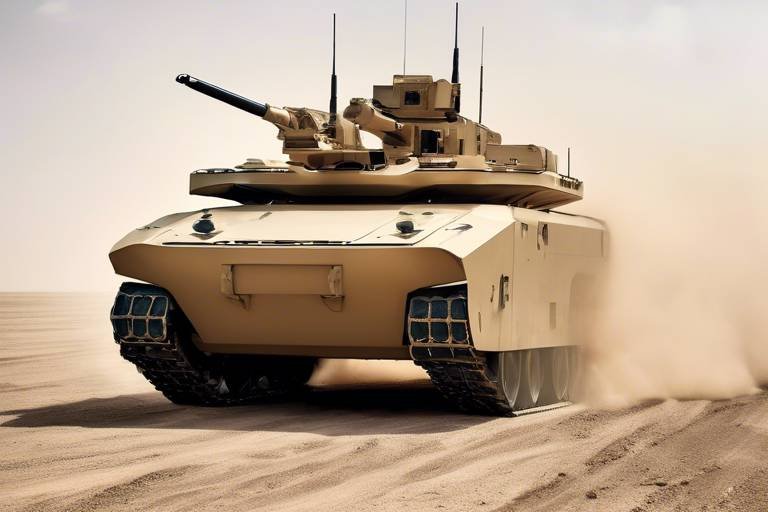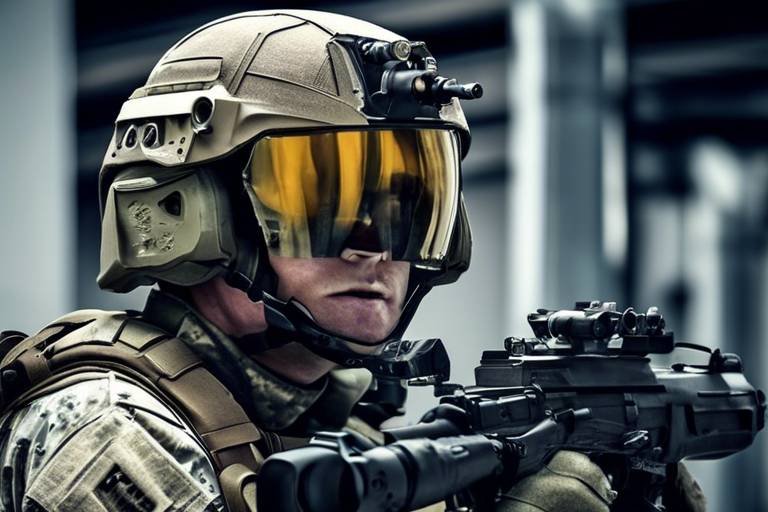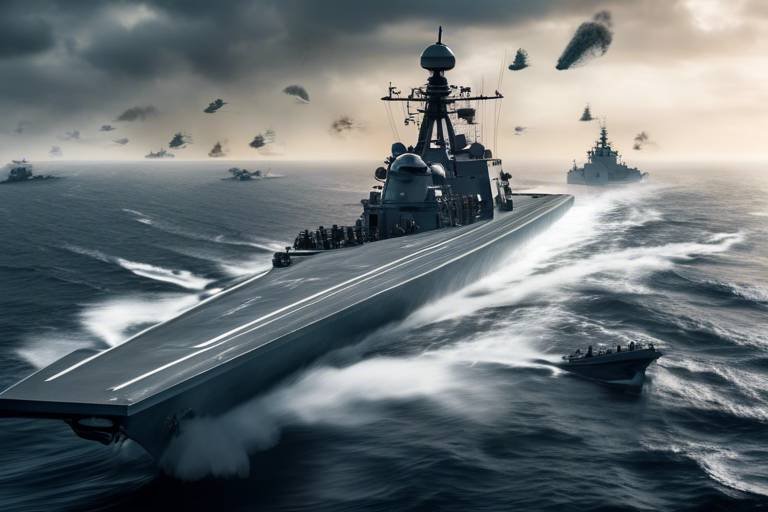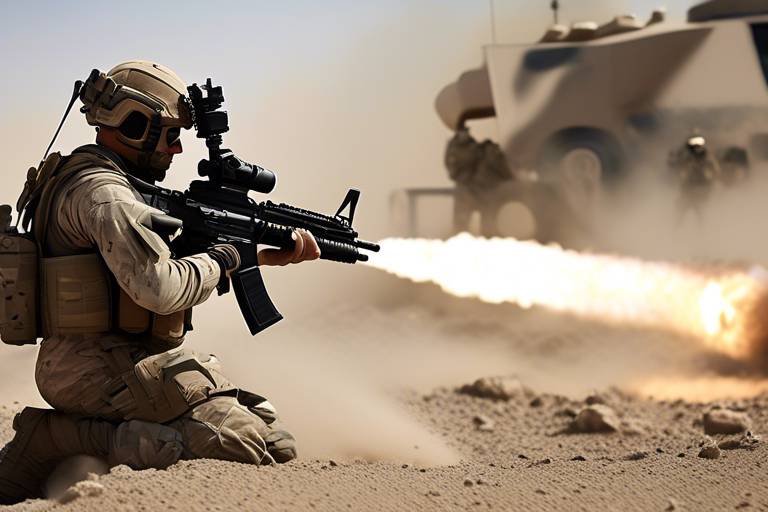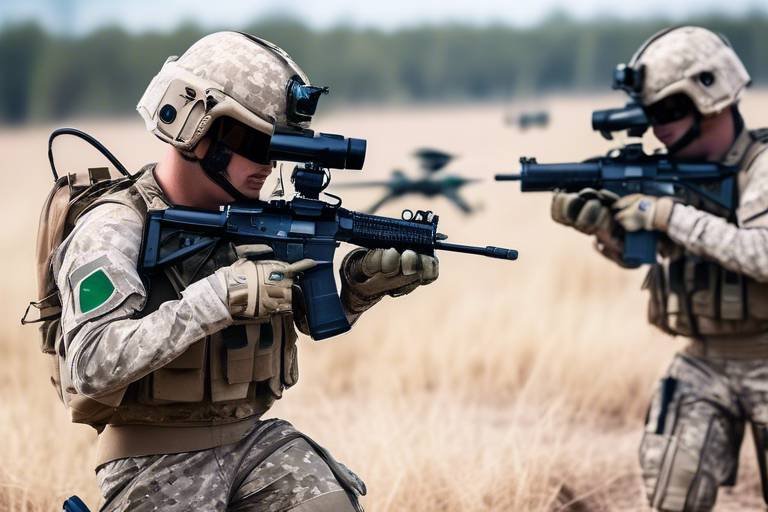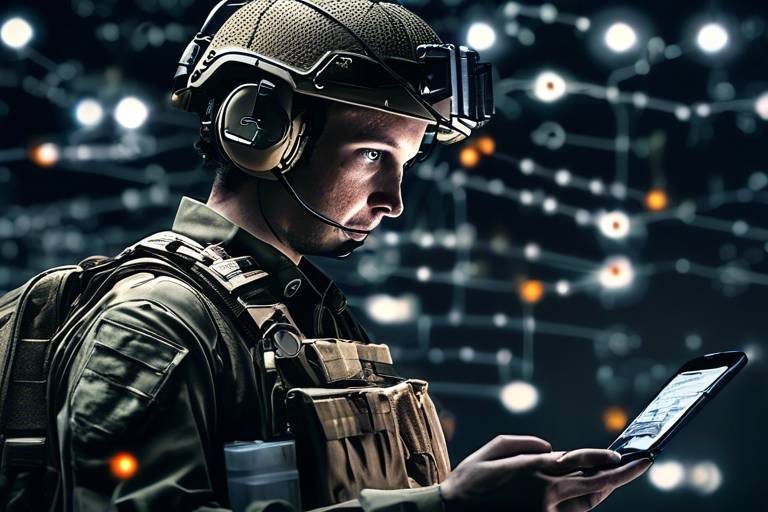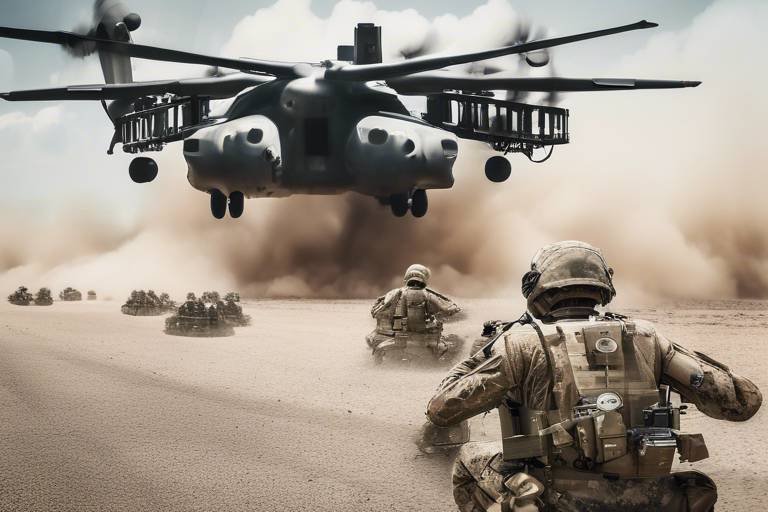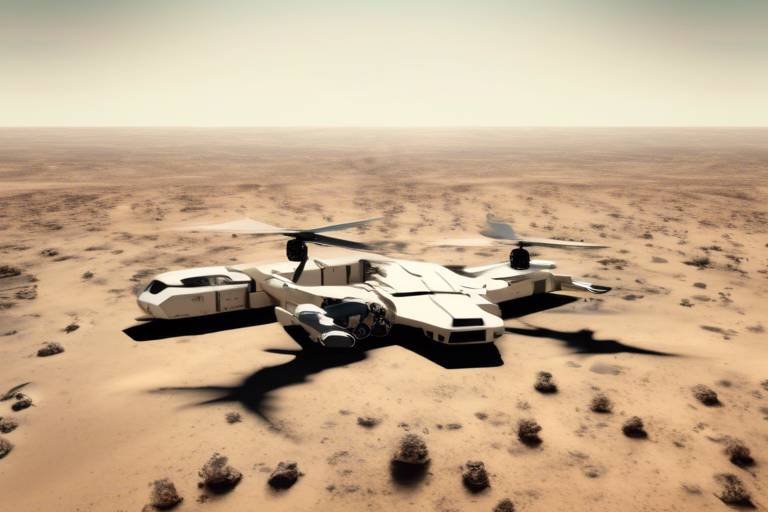Exploring Military-Civilian Partnerships for Innovation
In today’s rapidly evolving world, the **collaboration between military and civilian sectors** is not just beneficial; it's essential. As technology advances at breakneck speed, the intersection of defense needs and civilian innovation offers a unique opportunity to enhance national security and operational effectiveness. Imagine a scenario where cutting-edge technologies developed in the civilian sector are seamlessly integrated into military operations, creating a powerful synergy that drives progress and innovation. This article delves into the significance of these collaborations, highlighting innovative projects, shared resources, and the profound impact they have on technology and national security.
Understanding why partnerships between military and civilian sectors are crucial for driving innovation is fundamental. The military often operates in a high-stakes environment where the **need for rapid advancements** in technology can mean the difference between success and failure. On the other hand, the civilian sector is a hotbed of creativity and technological prowess, capable of developing solutions that can be adapted for military use. By **bridging the gap** between these two worlds, we can foster a culture of innovation that benefits both sides. This collaboration can lead to improved operational capabilities, enhanced training methods, and even breakthroughs in areas such as cybersecurity and logistics.
When we look at notable examples of military-civilian partnerships, the results speak for themselves. These collaborations have led to groundbreaking innovations that have not only advanced military strategy but have also had a lasting impact on civilian technology. For instance, initiatives like **Project Maven** and the **Defense Innovation Unit** exemplify how these partnerships can yield transformative results.
One of the most prominent examples is **Project Maven**, which leverages artificial intelligence to analyze drone footage. This initiative showcases the potential of military-civilian collaboration in technology. By utilizing AI, the military can process vast amounts of data quickly and accurately, allowing for better decision-making in the field. The integration of civilian tech companies into this project has been pivotal, as they bring expertise in AI and machine learning that enhances military operations.
Examining how artificial intelligence is transforming military operations reveals a landscape ripe for innovation. The role of civilian tech companies in this integration cannot be overstated. They are not just suppliers; they are partners in developing solutions that can redefine military capabilities. The potential applications of AI in defense are vast, ranging from predictive maintenance of equipment to real-time analysis of battlefield scenarios.
However, the use of AI in military applications raises significant ethical considerations. Questions about accountability, bias, and the potential for misuse loom large. Civilian input is crucial in navigating these challenges, ensuring that the deployment of AI technologies adheres to ethical standards. This collaborative approach can help establish guidelines that balance innovation with responsibility.
Another noteworthy initiative is the **Defense Innovation Unit (DIU)**, which actively fosters partnerships with startups and tech companies to accelerate innovation in defense technologies. The DIU serves as a conduit, connecting the military with cutting-edge civilian innovations. This collaboration not only enhances military capabilities but also brings new technologies to the civilian market, creating a win-win scenario.
Despite the promising potential of military-civilian partnerships, several challenges hinder effective collaboration. Bureaucratic hurdles, cultural differences, and security concerns can complicate these relationships. Understanding and addressing these barriers is essential for fostering a productive partnership.
National security considerations can complicate collaborations between military and civilian sectors. The need to protect sensitive information and technologies is paramount. Measures such as **security clearances** and strict protocols are often necessary to safeguard classified information while still allowing for innovation. Balancing these security needs with the desire for collaboration is a delicate dance.
Moreover, the varying mindsets and operational styles of military and civilian sectors can impact successful partnerships. The military often operates under strict protocols and a chain of command, while civilian companies may foster a more flexible, innovative approach. Understanding these cultural differences is vital for establishing effective communication and collaboration.
Looking ahead, the future of military-civilian partnerships appears promising, especially with the rise of emerging technologies. As we explore how these collaborations may evolve, it becomes clear that the potential for increased innovation is immense.
Emerging technologies such as **quantum computing** and **biotechnology** are set to shape the future of military-civilian partnerships. These advancements promise to revolutionize various aspects of military operations, from enhanced data processing capabilities to new methods of warfare. The collaboration between military and civilian sectors will be crucial in harnessing these technologies for national defense.
To maximize the benefits of military-civilian partnerships for innovation, policymakers must create an environment that encourages collaboration. This includes simplifying bureaucratic processes, fostering open communication, and providing incentives for civilian companies to engage with the military. Such efforts can help ensure that both sectors benefit from the shared knowledge and resources.
- What are the main benefits of military-civilian partnerships?
These partnerships enhance innovation, improve operational effectiveness, and lead to advancements in technology that benefit both sectors. - How can ethical concerns regarding AI in military applications be addressed?
By involving civilian experts in the development and implementation of AI technologies, ethical standards can be established and maintained. - What role do startups play in military-civilian collaborations?
Startups often bring fresh ideas and innovative solutions that can be rapidly adapted for military applications, driving technological advancements.

The Importance of Military-Civilian Collaboration
In today's rapidly evolving world, the need for collaboration between military and civilian sectors has never been more pronounced. This partnership is not merely beneficial; it's essential for driving innovation and enhancing operational effectiveness across both domains. Think of it as a powerful engine: the military brings its rigorous discipline and strategic focus, while the civilian sector contributes its creativity and technological advancements. Together, they can tackle complex challenges that neither could overcome alone.
One of the primary reasons for fostering these partnerships is the shared access to resources. By pooling their assets, both sectors can leverage cutting-edge technologies and research that might otherwise remain untapped. For instance, civilian tech companies are often at the forefront of advancements in fields like artificial intelligence, biotechnology, and cybersecurity. When these innovations are integrated into military operations, they can lead to enhanced capabilities and more effective strategies. This is a classic case of 1 + 1 3—the combined effort yields results greater than the sum of its parts.
Moreover, military-civilian collaboration can significantly accelerate the pace of innovation. The military often operates under stringent timelines and high stakes, which can drive rapid development and deployment of new technologies. On the other hand, civilian sectors are typically more agile and less encumbered by bureaucracy. When these two worlds collide, we witness a dynamic exchange of ideas and practices that can lead to groundbreaking advancements. For example, the integration of civilian-developed software into military operations can streamline processes, improve communication, and enhance situational awareness on the battlefield.
However, it's essential to recognize that the benefits of collaboration extend beyond just technological advancements. These partnerships also promote national security by ensuring that both sectors are aligned in their objectives. When military and civilian entities work together, they foster a shared understanding of security challenges and can develop comprehensive strategies to address them. This collaborative approach can lead to a more resilient society, better prepared to face threats, both foreign and domestic.
In summary, the importance of military-civilian collaboration cannot be overstated. It represents a synergistic relationship that drives innovation, enhances operational effectiveness, and strengthens national security. As we look to the future, it is crucial to continue nurturing these partnerships to unlock their full potential. The question remains: how can we further facilitate this collaboration to ensure that both sectors reap the maximum benefits?
- Why is military-civilian collaboration important? It is crucial for driving innovation, enhancing operational effectiveness, and promoting national security.
- What are some examples of successful military-civilian partnerships? Notable examples include Project Maven and the Defense Innovation Unit.
- What challenges do these collaborations face? Challenges include bureaucratic hurdles, cultural differences, and security concerns.
- How can we improve military-civilian partnerships? By fostering open communication, reducing bureaucratic barriers, and encouraging joint projects.

Successful Case Studies
When it comes to military-civilian partnerships, the results can be nothing short of astonishing. These collaborations have not only paved the way for innovative solutions but have also significantly enhanced operational effectiveness across various domains. Let's dive into some remarkable case studies that exemplify how these partnerships can lead to groundbreaking advancements.
One of the most noteworthy examples is Project Maven, a U.S. Department of Defense initiative that harnesses the power of artificial intelligence to analyze vast amounts of drone footage. Imagine having to sift through hours of video to identify potential threats—it's a daunting task. However, with the integration of AI, this process is streamlined, allowing military personnel to focus on critical decision-making rather than being bogged down by data overload. This project is a prime illustration of how civilian tech companies, like Google and other startups, are stepping in to provide innovative solutions that enhance military capabilities.
The integration of AI into military operations is a game-changer. Civilian tech firms bring cutting-edge technology and fresh perspectives, which can revolutionize how the military approaches various challenges. For instance, AI can assist in predictive maintenance of equipment, ensuring readiness and reducing downtime. This collaboration not only improves military efficiency but also opens new avenues for civilian companies to test and refine their products in real-world scenarios.
However, the use of AI in military applications raises some ethical concerns. Questions about accountability, bias in algorithms, and the potential for autonomous decision-making in combat situations are at the forefront of this discussion. Civilian input is crucial in navigating these challenges, as tech companies can help establish ethical frameworks that ensure responsible use of their innovations. By fostering open dialogue between military and civilian sectors, we can address these issues head-on and ensure that technology serves humanity’s best interests.
Another successful example of military-civilian collaboration is the Defense Innovation Unit (DIU). This organization was established to bridge the gap between the Department of Defense and the tech industry. By partnering with startups and established tech companies, DIU accelerates the development of innovative defense technologies. The unit focuses on areas such as artificial intelligence, machine learning, and cybersecurity, bringing together the best minds from both sectors to tackle pressing national security challenges. This collaborative approach not only enhances military capabilities but also fosters a vibrant ecosystem of innovation within the tech community.
In summary, the successful case studies of Project Maven and the Defense Innovation Unit demonstrate the immense potential of military-civilian partnerships. By leveraging each other's strengths, these collaborations can lead to technological advancements that benefit both sectors, ultimately enhancing national security and operational effectiveness.
- What are military-civilian partnerships?
Military-civilian partnerships are collaborations between military organizations and civilian sectors, aimed at leveraging resources, expertise, and technology to drive innovation and improve national security.
- How does Project Maven work?
Project Maven utilizes artificial intelligence to analyze drone footage, helping military personnel identify potential threats more efficiently by automating the analysis process.
- What role does the Defense Innovation Unit play?
The Defense Innovation Unit fosters partnerships between the military and tech companies, accelerating the development of innovative technologies that enhance defense capabilities.
- Are there ethical concerns with military-civilian collaborations?
Yes, ethical concerns include accountability, bias in AI algorithms, and the implications of autonomous decision-making in military operations. Civilian input is vital in addressing these issues.

Project Maven
Project Maven, officially known as the Algorithmic Warfare Cross-Functional Team, represents a groundbreaking initiative aimed at harnessing the power of artificial intelligence (AI) to enhance military operations. Launched by the U.S. Department of Defense in 2017, this project focuses on analyzing vast amounts of drone footage to identify and track objects of interest. Imagine trying to find a needle in a haystack; that's essentially what military analysts face when sifting through hours of video. By leveraging AI, Project Maven transforms this daunting task into a more manageable and efficient process.
The core objective of Project Maven is to develop algorithms that can autonomously detect and categorize objects within the video feeds captured by drones. This capability not only streamlines the analysis process but also significantly reduces the time it takes to gather actionable intelligence. With the military operating in an increasingly complex and fast-paced environment, the ability to quickly interpret data can mean the difference between success and failure in operations.
Moreover, the collaboration between military and civilian tech companies has been pivotal in the success of Project Maven. By integrating expertise from the civilian sector, the military gains access to cutting-edge technologies and innovative solutions that may not be available internally. For instance, companies like Google have played a crucial role in developing the machine learning models that power Project Maven. This partnership exemplifies how military-civilian collaboration can lead to significant advancements in technology.
However, the integration of AI into military operations raises important ethical considerations. As the technology evolves, questions about accountability, transparency, and the potential for bias in AI algorithms become increasingly relevant. Civilian input is essential in navigating these challenges, ensuring that the technology is used responsibly and ethically. Engaging with ethicists, policymakers, and the public can help the military address these concerns, fostering a more transparent approach to the use of AI in defense.
In summary, Project Maven showcases the immense potential of military-civilian partnerships in driving innovation within the defense sector. By utilizing AI to analyze drone footage, the project not only enhances operational effectiveness but also highlights the importance of collaboration across sectors. As we look to the future, it’s clear that such partnerships will be vital in addressing the challenges and complexities of modern warfare.
- What is Project Maven? Project Maven is a U.S. Department of Defense initiative that uses artificial intelligence to analyze drone footage for military intelligence.
- How does AI improve military operations? AI enhances military operations by quickly processing and analyzing large amounts of data, allowing for faster decision-making.
- What are the ethical concerns associated with Project Maven? Ethical concerns include accountability, transparency, and potential biases in AI algorithms, which require careful consideration and civilian input.
- Which companies are involved in Project Maven? Notable companies, including Google, have partnered with the military to develop the AI technologies used in Project Maven.

AI Integration
Artificial Intelligence (AI) is not just a buzzword anymore; it's a game changer, especially in military operations. Imagine a world where drones can analyze vast amounts of data in real-time, allowing soldiers to make informed decisions faster than ever. This is the reality that AI integration brings to the table. By harnessing the power of AI, military forces can enhance their operational effectiveness, streamline processes, and improve situational awareness. The collaboration between military and civilian tech companies has been pivotal in making this possible, as they bring innovative solutions that were once thought to be the realm of science fiction.
One of the standout examples of AI integration in the military is through the use of machine learning algorithms to process drone footage. Instead of sifting through hours of video manually, AI can quickly identify patterns, track movements, and even detect anomalies. This capability not only saves time but also significantly reduces the risk of human error in decision-making. The speed at which AI can analyze information transforms the battlefield into a more informed environment, where decisions can be made based on data rather than instinct alone.
However, the integration of AI into military operations isn't without its challenges. The technology is evolving rapidly, and with it comes a host of ethical considerations. For instance, who is responsible if an AI system makes a mistake? To navigate these murky waters, civilian tech companies are stepping in to provide their expertise, ensuring that ethical frameworks are established alongside technological advancements. This collaboration is essential, as it helps the military understand the potential pitfalls of deploying AI in sensitive situations.
Moreover, the partnership between military and civilian sectors fosters a culture of innovation. When civilian companies work alongside the military, they bring fresh perspectives and cutting-edge technologies that can transform traditional military practices. This is particularly evident in the realm of data analytics and cybersecurity, where civilian innovations can be adapted to enhance military readiness. The synergy created through these partnerships not only accelerates technological advancements but also ensures that military personnel are equipped with the best tools available.
In summary, AI integration in military operations represents a monumental shift in how defense strategies are developed and executed. As we look towards the future, the collaboration between military forces and civilian tech companies will undoubtedly lead to even more groundbreaking innovations. The potential is limitless, and the benefits of such partnerships extend beyond national security—they promise a safer, more efficient world for all.
- What is AI integration in the military? AI integration refers to the incorporation of artificial intelligence technologies into military operations to enhance decision-making, improve efficiency, and increase operational effectiveness.
- How does AI improve military operations? AI improves military operations by analyzing vast amounts of data quickly, identifying patterns, and providing actionable insights that help military personnel make informed decisions.
- What are the ethical concerns surrounding AI in the military? Ethical concerns include accountability for mistakes made by AI systems, the potential for bias in decision-making, and the implications of autonomous weaponry.
- How can civilian tech companies contribute to military AI projects? Civilian tech companies can provide innovative solutions, expertise in AI technologies, and help establish ethical frameworks for the deployment of AI in military contexts.

Ethical Considerations
As we dive into the fascinating world of military-civilian partnerships, particularly in the realm of artificial intelligence, we must tread carefully on the ethical landscape that emerges. The integration of AI technologies in military applications raises a plethora of questions that challenge our moral compass. For instance, how do we ensure that these powerful tools are used responsibly? The potential for misuse is significant, and without proper oversight, we could find ourselves in a precarious situation where technology outpaces our ethical frameworks.
One of the primary concerns revolves around the accountability of AI systems. When a machine makes a decision, who is held responsible if that decision leads to unintended consequences? This question is not merely academic; it has real-world implications that could affect lives. For example, if an AI system misidentifies a target in a military operation, the repercussions could be disastrous. Civilian tech companies, often at the forefront of AI development, have a crucial role in ensuring that their technologies are designed with ethical considerations in mind. This includes implementing robust testing protocols and transparency in algorithms to mitigate risks.
Moreover, the issue of bias in AI systems cannot be overlooked. These systems learn from data, and if the underlying data is flawed or biased, the outcomes will reflect those biases. In military contexts, this could lead to disproportionate impacts on certain populations, exacerbating existing inequalities. Civilian partners must work diligently to identify and rectify biases in their algorithms, promoting fairness and justice in their applications. The collaboration between military and civilian sectors can serve as a powerful platform for addressing these ethical dilemmas, as it combines diverse perspectives and expertise.
In addition to accountability and bias, there is also the challenge of transparency. The military often operates under a veil of secrecy, which can be at odds with the principles of transparency that civilian sectors uphold. Finding a balance between operational security and the need for public accountability is essential. Engaging civilians in the conversation about AI's role in military operations can help bridge this gap, fostering a dialogue that emphasizes ethical standards and public trust.
Finally, the ethical implications of AI in warfare extend beyond immediate operational concerns. They touch on broader societal issues, such as the normalization of autonomous weapons systems. As we move towards a future where AI could potentially make life-and-death decisions, we must ask ourselves: what kind of world do we want to create? The integration of civilian perspectives can provide a necessary counterbalance to military objectives, ensuring that ethical considerations remain at the forefront of technological advancement.
In summary, while the collaboration between military and civilian sectors holds immense promise for innovation, it is imperative that we approach this partnership with a strong ethical framework. By addressing accountability, bias, transparency, and societal implications, we can harness the power of AI responsibly and ethically, paving the way for a future that prioritizes human dignity and security.
- What are the main ethical concerns regarding AI in military applications? The primary concerns include accountability for decisions made by AI, potential biases in algorithms, transparency in operations, and the broader societal implications of autonomous weapons systems.
- How can civilian tech companies ensure their AI technologies are ethically sound? By implementing robust testing protocols, promoting transparency in algorithms, and actively working to identify and rectify biases in their data.
- Why is transparency important in military-civilian partnerships? Transparency fosters public trust and accountability, ensuring that ethical standards are maintained even in sensitive military operations.
- What role do civilians play in shaping military AI applications? Civilians can provide diverse perspectives, challenge military objectives, and advocate for ethical considerations, ultimately guiding the responsible use of technology.

Defense Innovation Unit
The Defense Innovation Unit (DIU) serves as a pivotal bridge between the military and the civilian tech landscape, fostering partnerships that drive cutting-edge advancements in defense technologies. Established to harness innovative solutions from the commercial sector, the DIU aims to accelerate the adoption of emerging technologies that can enhance national security. Think of it as a matchmaking service, but instead of dating, it’s all about pairing military needs with the ingenuity of startups and established tech firms.
One of the core missions of the DIU is to identify and integrate commercial technologies into military operations. This initiative not only enhances the capabilities of the armed forces but also ensures that the military stays ahead of potential adversaries. The unit focuses on various technology domains, including artificial intelligence, autonomous systems, and cybersecurity. By collaborating with civilian companies, the DIU can tap into a wealth of innovation that may not be accessible through traditional defense contracting processes.
To illustrate the impact of the DIU, consider the following key areas of focus:
| Technology Area | Examples of Applications |
|---|---|
| Artificial Intelligence | Predictive maintenance, data analysis for threat detection |
| Cybersecurity | Advanced threat detection, secure communication systems |
| Autonomous Systems | Drones for surveillance, robotic systems for logistics |
The DIU employs a unique approach to innovation by leveraging rapid prototyping and iterative development. This means that instead of lengthy procurement processes, the DIU can quickly test and refine new technologies in real-world scenarios. This agility not only speeds up the deployment of new capabilities but also encourages a culture of experimentation within the military. The result? A more adaptable and responsive defense sector ready to tackle modern challenges.
However, the journey isn’t without its challenges. The DIU must navigate the complex landscape of military bureaucracy while ensuring that innovative solutions meet stringent security and operational requirements. This balancing act is crucial, as it allows the military to remain at the forefront of technological advancements while safeguarding national interests.
One notable example of the DIU's success is its collaboration with various tech startups to develop solutions for urgent military needs. By hosting pitch days and innovation challenges, the DIU invites entrepreneurs to present their ideas, creating a dynamic environment where creativity meets practicality. This not only fosters a spirit of collaboration but also opens the door for groundbreaking innovations that can transform military operations.
In conclusion, the Defense Innovation Unit exemplifies how military-civilian partnerships can lead to significant advancements in technology and strategy. By embracing the agility and creativity of the civilian sector, the DIU is not just enhancing military capabilities but also shaping a more innovative future for national defense.
- What is the primary goal of the Defense Innovation Unit?
The primary goal of the DIU is to accelerate the adoption of commercial technologies into military operations to enhance national security. - How does the DIU foster collaboration with civilian companies?
The DIU hosts pitch days and innovation challenges, allowing startups and tech firms to present their solutions directly to military leaders. - What types of technologies does the DIU focus on?
The DIU focuses on areas such as artificial intelligence, cybersecurity, and autonomous systems. - What challenges does the DIU face in its mission?
The DIU navigates military bureaucracy and security requirements while trying to integrate innovative solutions quickly.

Challenges in Collaboration
When it comes to military-civilian partnerships, the road to collaboration isn't always smooth. In fact, it can often resemble navigating a minefield. There are several challenges that can hinder effective collaboration between these two distinct sectors, and understanding these barriers is crucial for fostering innovation. One of the primary obstacles is the presence of bureaucratic hurdles. Both military and civilian organizations have their own sets of regulations and procedures, which can create a tangled web of red tape. This often leads to delays in project timelines and can stifle the agility that is typically needed for innovative solutions.
Moreover, the cultural differences between the military and civilian sectors can pose significant challenges. The military operates within a structured, hierarchical environment where decisions are made swiftly and executed with precision. In contrast, civilian organizations often embrace a more flexible and collaborative approach. This disparity in operational styles can lead to misunderstandings and friction, ultimately impacting the success of joint initiatives. For instance, a civilian tech company might prioritize creative brainstorming sessions, while military personnel may prefer a more directive approach to problem-solving, which can clash in collaborative settings.
Another critical factor to consider is security concerns. National security is paramount, and military projects often involve sensitive information that cannot be freely shared with civilian partners. This need for confidentiality can limit the scope of collaboration and may lead to a lack of transparency, which is essential for building trust between parties. As a result, civilian companies might find themselves in the dark regarding certain military needs or constraints, making it difficult to propose effective solutions. To address these security challenges, both sides must engage in open dialogue and establish clear guidelines that protect sensitive information while allowing for meaningful collaboration.
To give you a clearer picture, let’s look at a few of the main challenges in military-civilian collaboration:
| Challenge | Description |
|---|---|
| Bureaucratic Hurdles | Complex regulations and procedures that slow down decision-making and project execution. |
| Cultural Differences | Diverging operational styles and mindsets that can lead to misunderstandings and conflict. |
| Security Concerns | Restrictions on sharing sensitive information that can hinder transparency and trust. |
Despite these challenges, it’s important to recognize that they are not insurmountable. By actively addressing these issues through improved communication, mutual respect, and a willingness to adapt, military and civilian organizations can pave the way for successful partnerships. After all, innovation flourishes in environments where diverse perspectives come together, and overcoming these barriers is essential for unlocking the full potential of military-civilian collaborations.
- What are the primary challenges in military-civilian partnerships?
The main challenges include bureaucratic hurdles, cultural differences, and security concerns. - How can these challenges be addressed?
Improved communication, mutual respect, and flexibility in approaches can help overcome these barriers. - Why is collaboration important?
Collaboration between military and civilian sectors drives innovation and enhances operational effectiveness in both domains.

Security Concerns
When it comes to military-civilian partnerships, one of the most pressing issues that surfaces is . These concerns often act as a double-edged sword, where the need for innovation clashes with the imperative to protect sensitive information. The military operates under stringent regulations and protocols designed to safeguard national security, which can sometimes create friction with civilian entities that may not fully grasp the implications of these restrictions.
For instance, when civilian tech companies collaborate with military organizations, they often encounter challenges related to data sharing and information access. The military's need to protect classified information can lead to a cautious approach in sharing data, which in turn can stifle the innovative potential of civilian partners. This begs the question: how can both sectors find a middle ground that fosters innovation while ensuring security?
Moreover, the fear of intellectual property theft is another significant concern. In a world where cyber threats are increasingly sophisticated, military entities are understandably wary of exposing their technological advancements to potential adversaries. This concern is not unfounded; instances of cyber espionage have highlighted the vulnerabilities that exist when sensitive information is shared across different sectors. To mitigate these risks, it is essential for both military and civilian partners to establish robust frameworks for protecting sensitive data while still allowing for meaningful collaboration.
In addition to these challenges, the cultural differences between military and civilian organizations can further complicate security considerations. The military often operates under a hierarchical structure with a focus on discipline and protocol, while civilian companies may adopt a more flexible and innovative approach. This disparity can lead to misunderstandings regarding security protocols and the importance of adhering to them, potentially jeopardizing the success of collaborative projects.
To address these security concerns, several measures can be implemented:
- Clear Communication: Establishing open lines of communication between military and civilian partners can help clarify expectations and protocols related to security.
- Joint Security Protocols: Developing joint security protocols that both parties agree upon can create a standardized approach to handling sensitive information.
- Regular Training: Conducting regular security training sessions for both military and civilian personnel can enhance awareness and compliance with security measures.
Ultimately, while security concerns pose significant challenges to military-civilian partnerships, they are not insurmountable. By fostering a culture of collaboration and understanding, both sectors can work towards innovative solutions that enhance national security without compromising on technological advancement.
- What are the main security concerns in military-civilian partnerships?
The primary concerns include data sharing restrictions, intellectual property theft, and cultural differences in operational protocols. - How can these security concerns be mitigated?
By establishing clear communication, joint security protocols, and conducting regular training sessions for personnel from both sectors. - Why is data sharing important in these collaborations?
Data sharing is crucial for fostering innovation and ensuring that both military and civilian partners can effectively contribute to projects.

Cultural Differences
When we talk about military-civilian partnerships, it's essential to recognize that these two sectors often come from vastly different worlds. The military operates under a strict hierarchy, where orders are followed without question, and the pace is often dictated by the urgency of national security. On the other hand, the civilian sector thrives on innovation, flexibility, and creativity. This fundamental difference can lead to misunderstandings and inefficiencies if not addressed properly.
Imagine a dance where one partner is performing a well-rehearsed routine while the other is improvising. The result can be a beautiful fusion of styles, or it can lead to a chaotic misstep. In the context of military-civilian partnerships, both sides can bring unique strengths to the table, but they must first understand and respect each other's approaches. For instance, while the military may prioritize discipline and precision, civilian companies often value agility and risk-taking. This contrast can lead to friction, especially when timelines and expectations do not align.
Moreover, the communication styles between these two sectors can differ significantly. Military personnel are trained to be concise and direct, often using jargon that may not resonate with civilians. Conversely, civilian professionals may prefer a more collaborative and open-ended dialogue. This divergence can create barriers to effective communication, making it challenging to establish a common ground. To bridge this gap, both sides must invest time in understanding each other's terminologies, workflows, and decision-making processes.
Another critical aspect is the cultural perception of failure. In the civilian world, failure is often seen as a stepping stone to success—a learning opportunity. However, in the military, failure can have severe consequences, particularly when lives are at stake. This difference in how failure is perceived can lead to hesitance in taking risks during collaborative projects. To foster a more productive partnership, both sectors need to cultivate a culture that embraces learning from mistakes, allowing for innovative solutions to emerge.
To address these cultural differences effectively, it may be beneficial to implement structured programs that promote cross-sector training. Such initiatives could involve:
- Joint workshops to foster understanding of each sector’s operational styles.
- Shadowing programs where military personnel spend time in civilian companies and vice versa.
- Regular feedback sessions to discuss challenges and successes in collaboration.
Ultimately, recognizing and respecting these cultural differences is not just about avoiding conflict; it’s about harnessing the strengths of both sectors to drive innovation and achieve shared goals. By creating an environment where military and civilian personnel can learn from each other, we can pave the way for more effective partnerships that enhance national security and push the boundaries of technology.
- What are the main cultural differences between military and civilian sectors?
The military emphasizes hierarchy, discipline, and precision, while the civilian sector values innovation, flexibility, and collaboration. - How can these cultural differences impact collaboration?
Misunderstandings and inefficiencies can arise due to differing communication styles, expectations, and perceptions of failure. - What steps can be taken to bridge the cultural gap?
Implementing cross-sector training programs, joint workshops, and regular feedback sessions can foster understanding and improve collaboration.

The Future of Military-Civilian Partnerships
As we peer into the crystal ball of innovation, the future of military-civilian partnerships appears not just promising but revolutionary. These collaborations are set to evolve dramatically, driven by the relentless pace of technological advancement and the pressing need for national security. Imagine a world where the boundaries between military and civilian sectors blur, creating a synergistic environment that fosters cutting-edge solutions to complex challenges.
One of the most exciting prospects lies in the realm of emerging technologies. Fields like quantum computing, biotechnology, and advanced robotics are not just buzzwords; they represent the next frontier in defense capabilities. For instance, quantum computing could potentially unlock new levels of data processing and encryption, making military operations more efficient and secure. As civilian tech companies lead the charge in these areas, their collaboration with the military will be crucial in harnessing these technologies for defense applications.
But how do we ensure that these partnerships are effective? The answer lies in fostering a culture of innovation and trust. Both military and civilian sectors need to embrace a mindset that values experimentation and adaptability. This means creating environments where ideas can flow freely, and where failures are seen as stepping stones rather than setbacks. By encouraging open communication and shared goals, we can build partnerships that are not only productive but also resilient against the challenges that lie ahead.
Moreover, policymakers play a vital role in shaping the future of these collaborations. By establishing frameworks that promote transparency and accountability, we can alleviate concerns surrounding national security and intellectual property. For example, creating joint task forces that include representatives from both sectors can help streamline processes and enhance cooperation. This collaborative approach can lead to more agile responses to emerging threats and opportunities.
In conclusion, the future of military-civilian partnerships is not just about technology; it's about people. It's about building relationships that transcend traditional boundaries and foster a shared vision for national security and innovation. As we look forward, let's embrace the potential of these collaborations and work together to create a safer, more innovative world.
- What are military-civilian partnerships?
Military-civilian partnerships refer to collaborations between defense organizations and civilian industries aimed at enhancing innovation, technology development, and operational effectiveness. - Why are these partnerships important?
They are crucial for driving innovation, sharing resources, and addressing complex national security challenges through combined expertise. - What role do emerging technologies play?
Emerging technologies like quantum computing and biotechnology are expected to shape the future of military-civilian collaborations, providing new capabilities and solutions for defense. - How can policymakers enhance these partnerships?
By creating supportive frameworks that promote transparency, accountability, and joint initiatives, policymakers can facilitate more effective collaborations.

Emerging Technologies
As we look to the future, the landscape of military-civilian partnerships is being reshaped by a wave of . These innovations are not just buzzwords; they represent a profound shift in how military operations are conducted and how civilian tech companies can contribute to national security. Imagine a world where quantum computing can crack codes faster than ever, or where biotechnology leads to breakthroughs in soldier health and performance. The potential is enormous, and the implications for both sectors are staggering.
One of the most exciting aspects of these technologies is their ability to drive collaboration between military and civilian entities. For instance, quantum computing holds the promise of revolutionizing data processing capabilities. This could enable military analysts to make faster, more informed decisions based on real-time data. On the civilian side, tech companies are eager to explore quantum applications, creating a fertile ground for partnerships. By working together, they can unlock new levels of efficiency and capability.
Another area ripe for collaboration is biotechnology. From enhancing the resilience of soldiers to developing advanced medical treatments, the military's interest in biotech has surged. Civilian biotech firms have the expertise and innovation needed to push these frontiers. Consider the potential for advanced prosthetics or regenerative medicine that could drastically improve the quality of life for injured veterans. The intersection of military needs and civilian innovation could lead to groundbreaking advancements that benefit both sectors.
However, the integration of these technologies into military operations is not without its challenges. A key concern is ensuring that the technology is secure and that sensitive military data is protected. As civilian companies often operate in more open environments, there is a need for stringent security protocols to safeguard national interests. This is where the military's experience with security can complement civilian innovation, creating a robust framework that ensures safety while fostering innovation.
Moreover, the ethical implications of these emerging technologies cannot be overlooked. As we delve deeper into AI, biotechnology, and quantum computing, questions arise about the moral responsibilities of both sectors. Civilian companies can play a crucial role in shaping the ethical landscape, ensuring that innovations are developed with a strong moral compass. For example, discussions around the use of AI in combat scenarios are vital. Civilian input can help the military navigate these complex waters, ensuring that technological advancements align with societal values.
In conclusion, the future of military-civilian partnerships is bright, fueled by emerging technologies that promise to transform both sectors. By embracing collaboration and addressing the associated challenges, we can harness the full potential of these innovations. The synergy created by combining military expertise with civilian creativity could lead to unprecedented advancements, ultimately enhancing national security and improving lives.
- What are some examples of emerging technologies in military-civilian partnerships?
Emerging technologies include quantum computing, biotechnology, and artificial intelligence. These technologies are being explored for their potential to enhance military operations and improve civilian applications.
- How can civilian companies contribute to military innovation?
Civilian companies can provide cutting-edge technology, innovative solutions, and ethical guidance, helping the military to adopt new technologies effectively and responsibly.
- What are the security concerns associated with military-civilian collaborations?
Security concerns include the protection of sensitive military data, ensuring that civilian technologies meet military standards, and addressing potential vulnerabilities in open environments.
- Why is ethical consideration important in military-civilian partnerships?
Ethical considerations are crucial to ensure that technological advancements align with societal values and do not lead to misuse or unintended consequences in military applications.

Policy Recommendations
To truly unlock the potential of military-civilian partnerships, it's essential to adopt a multi-faceted approach that addresses the unique challenges and opportunities presented by these collaborations. Policymakers must prioritize the establishment of clear frameworks that facilitate communication and collaboration between military and civilian entities. This involves not only creating guidelines for interaction but also fostering an environment where innovation can thrive. For instance, establishing innovation hubs within military bases can serve as incubators for new ideas, where civilian tech companies can work alongside military personnel to develop cutting-edge solutions.
Furthermore, it's crucial to invest in training programs that bridge the cultural gap between military and civilian sectors. These programs should focus on enhancing mutual understanding of operational goals, methodologies, and terminologies. By engaging in joint exercises and workshops, both sides can learn from each other, ultimately leading to more effective collaborations. For example, a program that allows civilian engineers to experience military operations firsthand can provide invaluable insights into the specific needs and constraints faced by military personnel.
In addition to training, funding mechanisms should be established to support collaborative projects. This could involve grants specifically aimed at joint ventures between military and civilian organizations. By providing financial incentives, policymakers can encourage innovative projects that might not have been pursued otherwise. A well-structured funding initiative could also help address the issue of resource allocation, ensuring that both sectors contribute equitably to the partnership.
Moreover, it’s essential to address the ethical considerations surrounding military-civilian collaborations, particularly in the realm of technology. Policymakers should create ethical guidelines that govern the use of emerging technologies, such as artificial intelligence and biotechnology, in military applications. Engaging civilian experts in these discussions can help ensure that ethical standards are upheld while still allowing for innovative advancements. This collaborative approach can also build public trust, which is vital for the success of such partnerships.
Lastly, as we look toward the future, it’s important to remain adaptable. The landscape of technology and security is ever-evolving, and so too should be the policies that govern military-civilian partnerships. Regular assessments and updates to policies will ensure that they remain relevant and effective in fostering innovation. By being proactive and responsive, policymakers can help create an ecosystem where military-civilian partnerships not only survive but thrive, ultimately benefiting national security and technological advancement.
- What are military-civilian partnerships? These are collaborations between military organizations and civilian sectors aimed at enhancing innovation and operational effectiveness.
- Why are these partnerships important? They drive technological advancements, improve national security, and foster resource sharing between sectors.
- What challenges do these partnerships face? Common challenges include bureaucratic hurdles, cultural differences, and security concerns that can complicate collaboration.
- How can policymakers enhance military-civilian partnerships? By establishing clear frameworks, investing in training, providing funding, addressing ethical considerations, and remaining adaptable to change.
Frequently Asked Questions
- What are military-civilian partnerships?
Military-civilian partnerships refer to collaborations between military organizations and civilian sectors, including businesses and research institutions. These partnerships aim to leverage shared resources, expertise, and technologies to drive innovation and enhance operational effectiveness in both domains.
- Why are these partnerships important for innovation?
These partnerships are crucial because they combine the agility and creativity of civilian sectors with the strategic needs and resources of the military. This synergy fosters groundbreaking innovations that can improve technology, enhance national security, and address complex challenges faced by both parties.
- Can you give examples of successful military-civilian collaborations?
Absolutely! One notable example is Project Maven, which uses artificial intelligence to analyze drone footage. Another is the Defense Innovation Unit, which partners with startups to accelerate defense technologies. These projects showcase how effective collaboration can lead to significant advancements.
- What are the challenges faced in military-civilian partnerships?
Challenges include bureaucratic hurdles, cultural differences between military and civilian sectors, and security concerns. These factors can complicate collaboration and slow down the innovation process. Addressing these issues is essential for successful partnerships.
- How does national security impact these collaborations?
National security considerations can complicate military-civilian partnerships by imposing restrictions on information sharing and technology transfer. It’s important for both sectors to find a balance that allows for innovation while ensuring that sensitive information remains protected.
- What role do emerging technologies play in the future of these partnerships?
Emerging technologies like quantum computing and biotechnology are expected to shape the future of military-civilian partnerships significantly. These advancements can provide new tools and methodologies that enhance operational capabilities and drive further innovation.
- What recommendations can enhance military-civilian collaboration?
Policymakers can enhance collaboration by streamlining regulations, promoting open communication, and encouraging joint initiatives. Creating an environment that values innovation and shared goals will maximize the benefits of these partnerships for both military and civilian sectors.








